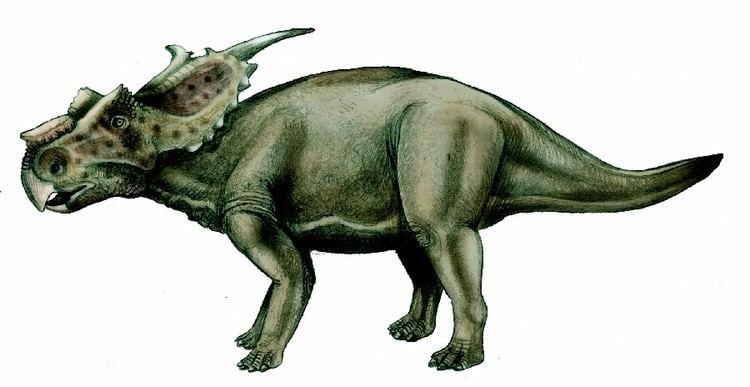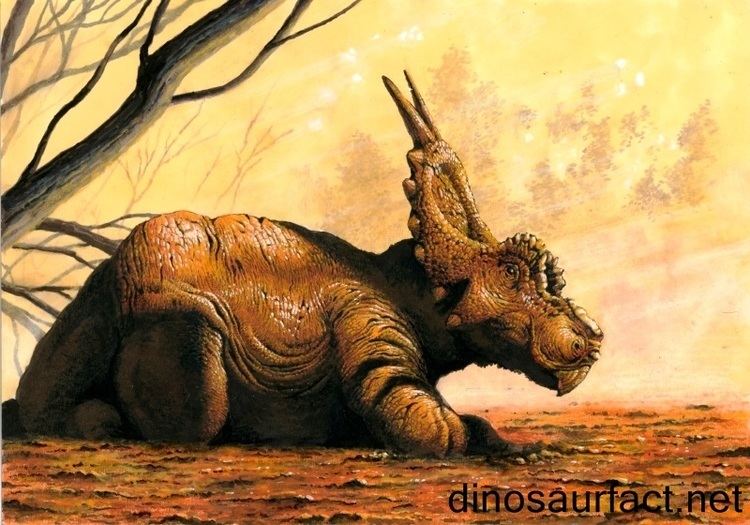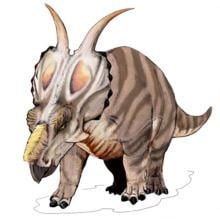Kingdom Animalia Family †Ceratopsidae Subtribe †Pachyrostra Phylum Chordata Rank Genus | Clade Dinosauria Tribe †Pachyrhinosaurini Scientific name Achelousaurus Higher classification Pachyrhinosaurini Order Ornithischia | |
 | ||
Similar Dinosaur, Einiosaurus, Albertaceratops, Anchiceratops, Arrhinoceratops | ||
Daniel s dinosaur world achelousaurus
Achelousaurus ( /əˌkiːloʊˈsɔːrəs/, /ˌækᵻˌloʊəˈsɔːrəs/; "Achelous's lizard") is a genus of centrosaurine ceratopsid dinosaurs from the Late Cretaceous Period of what is now North America, dated to 74.2 million years ago.
Contents
- Daniel s dinosaur world achelousaurus
- Achelousaurus dinosaur of the day
- DescriptionEdit
- History of discoveryEdit
- ClassificationEdit
- References

Achelousaurus dinosaur of the day
DescriptionEdit

They were quadrupedal herbivores with parrot-like beaks, rough bosses (raised bony areas) on their snouts and one pair behind their eyes, and a pair of horns on the end of their long bony frills. With body lengths of up to six meters (20 feet) and a weight of three tonnes, Achelousaurus were medium-sized ceratopsians.
History of discoveryEdit

The genus and the one named species (A. horneri) were both named by paleontologist Scott Sampson in 1995. The specific name honors Jack Horner, an influential American paleontologist famous for his Montana dinosaur discoveries, who in 1987 headed the team that excavated the holotype skull of Achelousaurus, MOR 485. The generic name Achelousaurus is a complex reference to Greek mythology. Achelous, an important Greek river deity, had one of his horns torn off by Hercules, in a mythological fight with the legendary hero. All three known skulls of Achelousaurus have rough bosses in the same places where other ceratopsians have horns, giving them the appearance of having had the horns ripped off. Achelous was also celebrated for his shapeshifting ability, just as Achelousaurus appear to combine features of other ceratopsian dinosaurs.

Achelousaurus horneri are known from the U.S. state of Montana, in the Two Medicine Formation, which preserves sediments dated from the Campanian stage of the Late Cretaceous Period, between 83 and 74 million years ago. Achelousaurus specimens are found in the highest levels of the formation, probably closer to the end of that timeframe, 74 mya. Contemporary dinosaur species included Prosaurolophus blackfeetensis, Scolosaurus cutleri, Hypacrosaurus stebingeri, Einiosaurus procurvicornis, and tyrannosaurids of uncertain classification.
Scientists have so far recovered three skulls and some postcranial material from the Two Medicine, all housed at the Museum of the Rockies in Bozeman, Montana. The skull of a full-grown Achelousaurus (including the frill horns) is over 5 feet (1.6 meters) long.
ClassificationEdit
Early reports suggested that Achelousaurus represented a transitional form, "Type C", between ceratopsians with modified horns like Einiosaurus, "Type B" (with which A. horneri shares two horns on the end of the frill), and the derived, hornless Pachyrhinosaurus (Horner et al., 1992). While they may or may not form a direct line of descent, all three of these genera are at least closely related, and are often united in the tribe Pachyrhinosaurini, inside the subfamily Centrosaurinae and the family Ceratopsidae (Sampson, 1995; Dodson et al., 2004).
The cladogram below shows the phylogenetic position of Achelousaurus following Ryan et al. (2016):
